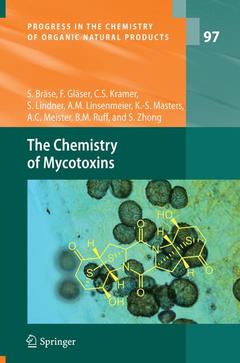Description
The Chemistry of Mycotoxins, 2013
Progress in the Chemistry of Organic Natural Products Series, Vol. 97
Authors: Bräse Stefan, Gläser Franziska, Kramer Carsten, Lindner Stephanie, Linsenmeier Anna M., Masters Kye-Simeon, Meister Anne C., Ruff Bettina M., Zhong Sabilla
Language: English
Subjects for The Chemistry of Mycotoxins:
Keywords
Approximative price 316.49 €
In Print (Delivery period: 15 days).
Add to cartPublication date: 03-2015
Support: Print on demand
Approximative price 316.49 €
In Print (Delivery period: 15 days).
Add to cartPublication date: 02-2013
300 p. · 15.5x23.5 cm · Paperback
Description
/li>Contents
/li>Comment
/li>
Nowadays, many laboratories around the world are specialized in the detection of mycotoxins in food products and contaminated material found in housing.
In this volume, a focus on the most important classes of mycotoxins is provided and their chemistry of the last ten years is discussed. In each Section, the individual biological impact is outlined. Sections are arranged according to mycotoxin classes (e. g. aflatoxins) and/or structural classes (e. g. resorcinyl lactones, diketopiperazines). The biology of mycotoxins is also described.
1 Introduction.- 2 Aflatoxins.- 2.1 Biological Properties.- 2.2 Total Syntheses of Aflatoxins.- 2.3 Syntheses of Aflatoxin Building Blocks.- 2.4 Syntheses of Biosynthetic Aflatoxin Precursors.- 3 Citrinin.- 3.1 General.- 3.2 Total Syntheses of Citrinin.- 4 Ergot Alkaloids.- 4.1 Structural Subclasses of Ergot Alkaloids.- 4.2 Biological Properties.- 4.3 Total Syntheses.- 5 Fumonisins.- 5.1 Biological Properties.- 5.2 Total Syntheses.- 6 Ochratoxins.- 6.1 Biological Properties.- 6.2 Total Syntheses.- 7 Patulin.- 7.1 General.- 7.2 Total Syntheses of Patulin.- 8 Trichothecenes.- 8.1 Biological Properties.- 8.2 Total Syntheses.- 9 Resorcylic Acid Lactones.- 9.1 Biological Properties.- 9.2 Total Syntheses.- 10 (Thio)diketopiperazines.- 10.1 Biological Properties.- 10.2 Total Syntheses.- 11 Alternaria metabolites.- 11.1 Biological Properties.- 11.2 Total Syntheses.- 12 Skyrins.- 12.1 Biological properties.- 12.2 Syntheses of Skyrin Model Systems.- 12.3 Total Syntheses of Skyrins.- 13 Xanthones.- 13.1 Xanthones.- 13.2 Tetrahydroxanthones.- 13.3 Hexahydroxanthones.- 13.4 Xanthone Dimers and Heterodimers.- 13.5 Tetrahydroxanthone Dimers and Heterodimers.- 14 Cytochalasans.- 14.1 Biological Properties.- 14.2 Total Syntheses.- 15 Peptidic Mycotoxins.- 15.1 Biological Properties.- 15.2 Total Syntheses.- Abbreviations.- References.-
Extended review of mycotoxins
Individual biological impact of mycotoxins is discussed
Focus on the most important classes of mycotoxins
Includes supplementary material: sn.pub/extras
These books may interest you

Mycotoxins in Foodstuffs 210.99 €



